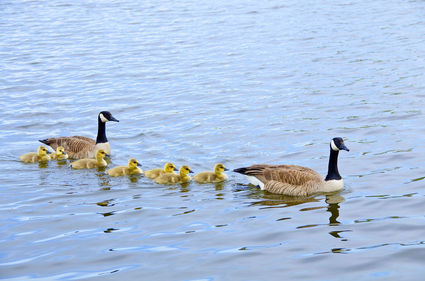"Kanata," Canada's Goose on the Loose
Last updated 5/25/2014 at 3:02pm

Thinkstockphotos.com
Canada geese are established from Canada's east coast to west coast, and from Mexico to the Arctic. They are loosed and thriving across the land. Canada geese start out in a large group but gradually form smaller ones. These may be families, pairs or several young geese known as yearlings. The giant Canada Goose is likely the most known populated water bird in North America.
Kanata is a Huron word for 'village' or 'settlement. The Hurons first named flocks of geese 'Kanata' because these birds bred close to Indian settlements. 'Kanata' was also the name given to the French settlement of Stadacona, now Quebec City and was conformed to the English name: Canada. That name was given to the geese as well. What came first? The goose's name or the country's name? Today, Canada geese are established from Canada's east coast to west coast, and from Mexico to the Arctic. They are loosed and thriving across the land. Canada geese start out in a large group but gradually form smaller ones. These may be families, pairs or several young geese known as yearlings. The giant Canada Goose is likely the most known populated water bird in North America. Their wing span can spread over six feet and they can weigh from 24-27 pounds. The only difference between the male and female, is size. The male is slightly larger. There are about 10 sub-species, all with the famous neck band but they only weigh in at about 3-5 pounds.
The highest rank is given to the Gander (male) with the most goslings (babies). The more goslings in the family, the bossier, the proud Gander!
However, fights for rank only break out between Ganders if they both have the same number of goslings. Sometimes, 2 year old geese will breed, but the normal breeding age is 3 years. When this happens, chances are the young parents, (the 2 year olds), will lose their brood to older, more aggressive pairs. It might even be their own parents that take them, so they (the new grandparents), can claim more goslings and gain the higher rank! This means the goslings of these young parents will be raised by their grandparents.
While they are in flight, they make a racket! The average Canada Goose belts out about ten or twelve different vocalizations. This is their way of communication with one another. Their cruising speed averages 30 miles an hour but will speed up to 40 mph during migration. If they are really pressed to reach their destination, they can fly at an astonishing speed of 60 mph!
Geese have proven to be loyal. If one goose gets sick or wounded, and falls out of formation, its mate or one or two other geese will follow it down to the spot it has landed. They will stay with the wounded goose to protect it, often risking their own lives, for as long as it takes for it to recover and fly again, or until it dies. Canada Geese that were banded, have recorded ages that vary from 12 to 80 years! One pair was recorded as having been together for 42 years. Although it's familiar that geese mate for life, research has discovered that the occasional divorce does occur. Most geese will select another mate after a partner's death, while a few will simply return to the same nest, alone, for many seasons. These remarkable birds do not change their route from year to year. A mated pair will always return to the same nesting place. The young learn the familiar route from their parents and once flying on their own, will still return to their birth places, year after year.
The female chooses the nesting area. A favorite location is atop of a muskrat house or a beaver dam, as long as it is close to water, she will accept man made nests, or re-use abandoned nests built by other birds such as owls, crows or hawks. Then she will re-decorate, using whatever materials are close by, twigs, grasses, leaves and moss. Later, she will line the nursery with her own down from her chest. She is planning ahead with good intentions as she picks the spot for the nest. Sitting on her eggs, she positions herself so she has a good view surrounding her, in case any predators try to approach the nest. Every female wants a 'room with a view', doesn't she?
The proud Gander, doesn't sit on the eggs, but he stays close and fearlessly defends the nesting area, from intruders. He decides how much territory should be privately owned. If he senses danger, he will spread his wings, hiss and create havoc. The Canadian Mother Goose lays her cream colored eggs anywhere from March to early June. She will lay one egg, every other day up to 12 eggs. The normal count is 5 to 8 eggs. Not necessarily 'cheaper by the dozen'.
The first eggs are pushed aside, and left camouflaged until all the eggs have been laid. It doesn't matter if they get cold. The female will start lining the nest with down from her own breast for comfortable insulation when she is half finished laying. Only when all her eggs are laid, will she begin incubating, so that the eggs hatch at the same time. This takes a further 25-30 days. She will stay on the nest the entire time, except for brief outings for food, water and bathroom breaks.
During this incubation time, the adults molt their flight feathers and are unable to fly, however, the male's sole purpose at this time, is to stay right by the nest to defend it. These feathers will grow back just in time for their fall migration. As soon as they do grow back, the parents teach their goslings to fly. The newborn goslings are lead to the water to swim within the first 24 hours of birth. They must gain about a pound per week to reach six to seven pounds in two months. Geese feed on tender marsh grasses, pond weeds, cattails, berries and salt grasses. They are seen by thousands in fall, foraging fields for grain or corn kernels left behind.
The parents are fiercely protective of their young as anyone who has ever tried to snatch one, or, gets too close, will find out. The large adults do not have many natural enemies but the goslings can fall prey to owls, hawks, or snapping turtles. Raccoons will go after the unattended eggs if allowed an unguarded moment. I could only imagine the wrath of Mama goose, if that happened while she was out on a much needed break and Dad was on duty!
If there are several families in the area, they congregate and share taking care of the goslings, adding strength and safety in numbers. Their migration date depends totally on the season and location. It is impossible to predict with perfect accuracy the exact date they will leave. The geese have their 'inside info' or instinct, as to when winter or spring will arrive, depending on where they are.
When the great migration is in progress, thousands upon thousands fill our sky, flying day and night. This usually happens from the middle to the end of September. Before this, geese will travel shorter distances and stop to feed themselves well and often, before their long difficult journey. They migrate in family groups and the new goslings stay with their parents for one full year.
Their distinctive V-shape formation is unique and for logical reason. They keep this shape while flying thousands of miles at a time as a way to assist one another. As each one flaps its wings, it creates an uplift for the flyer behind it. This allows them to cover greater distances than if flying on their own. Usually a female is the lead point while the males guard at the rear, and honk continuously to encourage those in front to keep up their speed. When the lead point gets tired, it changes position and another flies to the front and takes over. There can be no slacking at the point.
While living in Regina, Saskatchewan, I often took the children to Wascana Park to feed the geese. One day, a little one got left behind and was frantically calling as it climbed up the bank of the lake. I picked it up to see if I could find its family. Out of nowhere, appeared the adult in an outrage! It hissed and bit at me and did not stop until it had knocked me into the water! We learned NEVER to mess with any little ones again! They have many human-like traits, loyal, protective of their family and each other, and they are gifted with an impeccable memory. That goose came after me every time it saw me during that entire season!
I had no idea which baby I had touched, but its parent remembered.
Canada Geese, are a proud and magnificent bird. We are blessed to have any opportunity to enjoy them.
From generation to generation, year after year, we watch the flight of the beautiful 'Kanata' Geese. The sound of them honking is always a sign that summer is coming to an end. Their farewells stir a melancholy emotion in us, as they begin their migration south. Regardless of all the other signs that summer is nearly over, the formations of honking geese flying overhead always confirms that. In the spring, we welcome the sight and sounds of their return. Somehow, they create a feeling that 'all is right with the world' again.
The Creator has endowed them with an amazing instinct, beautiful markings, strength and courage and has given a season and a purpose for everything under the sun.
Just like people, there are no two 'Kanata' Geese exactly the same. Creator knows every feather on each one, as He knows every hair on our heads. We are fearfully, wonderfully made. We are all beautiful and have a purpose in the Creator's sight, and on this earth.
We can honor our Canada Geese by enjoying them and respecting their natural habitats so that generations who follow us will enjoy them too.












